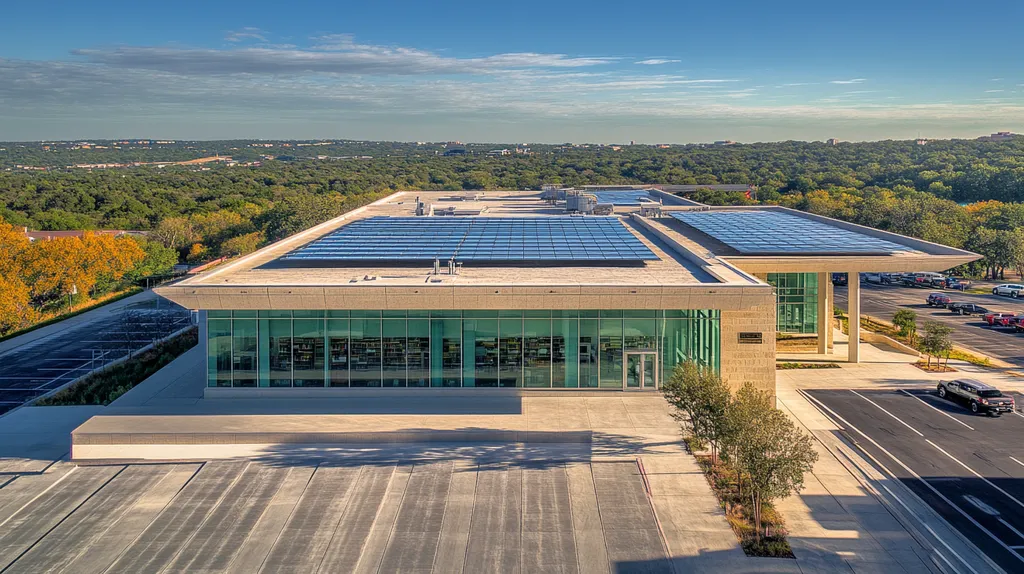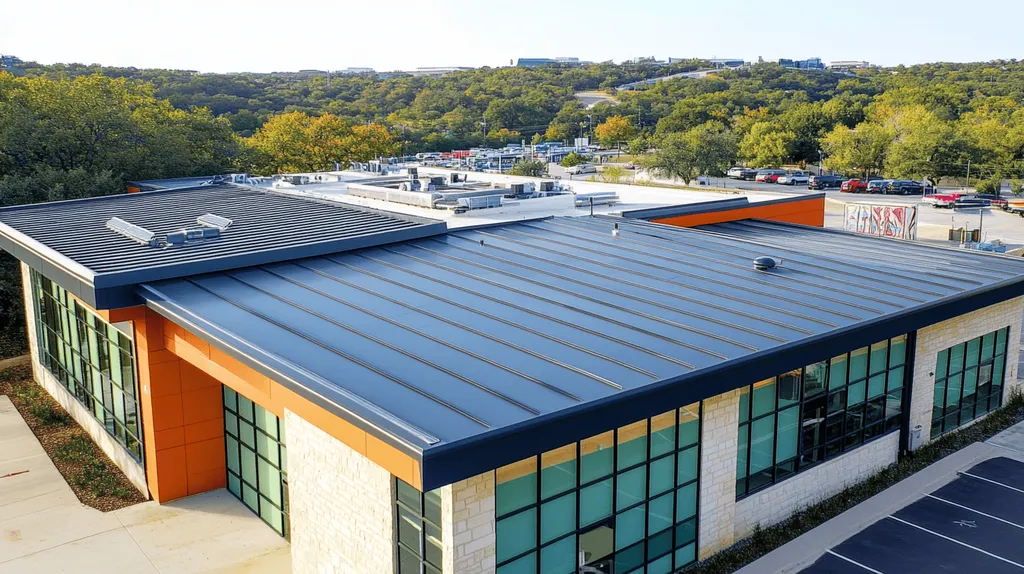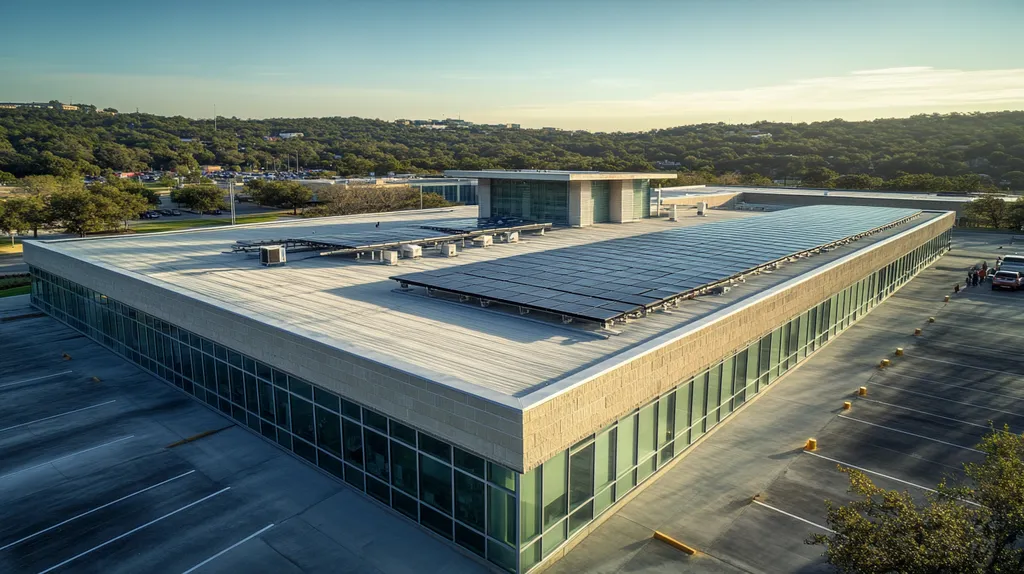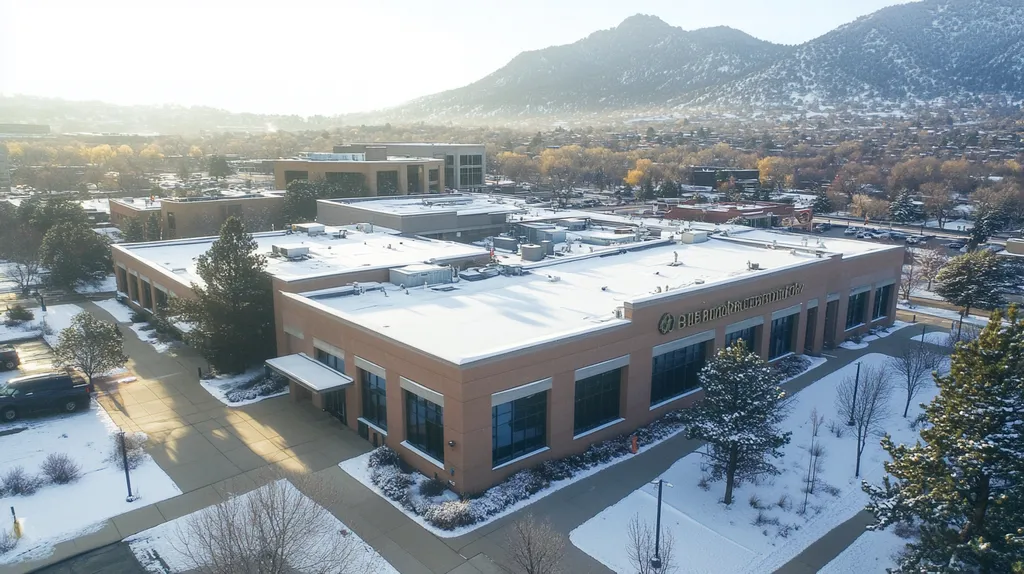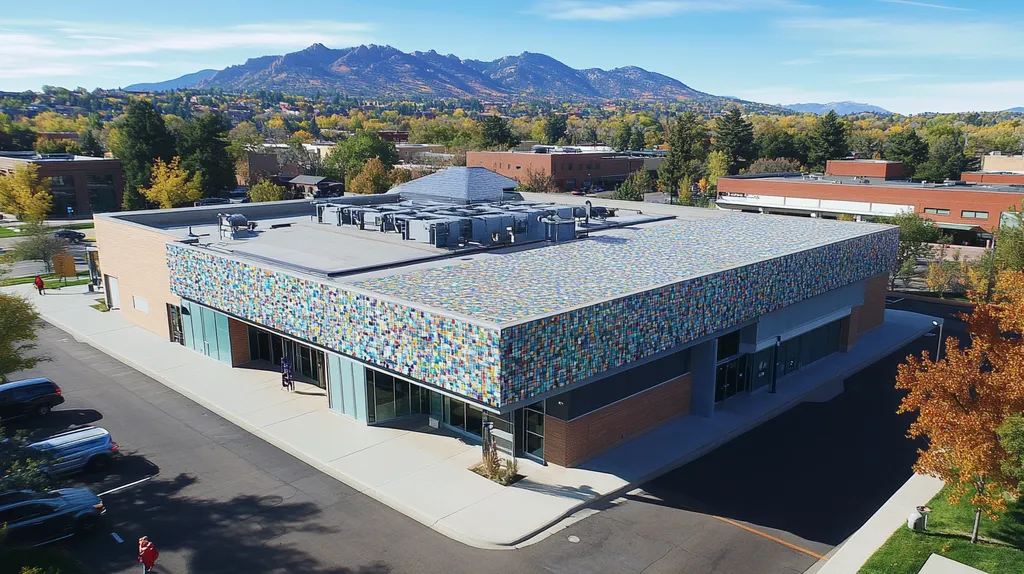In 2022, severe weather events caused over $22 billion in commercial property damage, with roof failures accounting for nearly 40% of these losses. As climate patterns intensify, traditional roofing approaches no longer provide adequate protection against extreme conditions.
Modern commercial roofs must withstand unprecedented challenges: 140+ mph winds, softball-sized hail, extreme temperature swings, and record-breaking rainfall. The combination of these forces creates complex stress patterns that can compromise even well-maintained systems.
This comprehensive guide examines the critical components, implementation methods, and maintenance strategies required to create and maintain weather-resistant commercial roofing systems that protect valuable business assets.
SECTION 1: FUNDAMENTAL CONCEPTS
Weather-related threats to commercial roofs have intensified dramatically in recent years, with extreme events causing unprecedented damage. In 2022 alone, severe storms resulted in over $15 billion in commercial property losses, with roofing failures accounting for a significant portion. Understanding how roofing systems respond to environmental stresses has become critical for protecting business operations and assets.
Understanding Weather-Related Roof Stress Factors
Commercial roofs face multiple simultaneous environmental challenges that can compromise their structural integrity. High winds, heavy precipitation, extreme temperature swings, and UV exposure create complex stress patterns that can accelerate deterioration.
Hail represents a particularly destructive force, capable of causing immediate damage that compromises the roof’s protective function. In hail-prone regions, roofing assemblies must meet stringent impact resistance standards including FM 4470 with Class 1-SH or UL 2218 Class 4 ratings to ensure adequate protection. (source: IBHS)
Snow load calculations must account for both immediate weight and the effects of freeze-thaw cycles. Accumulated snow can create pressure points that stress seams and flashings, while melting and refreezing patterns can force water into small openings.
UV radiation degrades roofing materials over time, making them more susceptible to other forms of damage. This deterioration often manifests as surface cracking, material shrinkage, and loss of protective coatings.
Principles of Roof Wind and Water Resistance
Wind uplift forces represent one of the most significant threats to roof integrity. These forces don’t simply push against the roof – they create complex pressure differentials that can literally pull roofing materials away from the structure.
Proper edge securement is crucial for wind resistance, as most roof failures begin at the perimeter. Metal edge systems must be properly engineered and installed to prevent the progressive failure that often starts with a single compromised section.
Water resistance depends on maintaining effective drainage paths and watertight barriers. Even minor ponding can accelerate material degradation and increase the risk of water infiltration during severe weather events.
Integration of multiple defensive layers, including proper underlayment and flashings, creates redundancy that helps maintain protection even if the primary membrane is compromised.
Thermal Movement and Material Compatibility
Daily and seasonal temperature changes cause roofing materials to expand and contract continuously. This movement stresses attachment points and can cause materials with different thermal expansion rates to separate over time.
Proper design must accommodate anticipated thermal movement through expansion joints and flexible connections. Rigid attachment methods that restrict natural movement often lead to material fatigue and premature failure.
Material compatibility extends beyond thermal properties to chemical interactions between different components. Some common roofing materials can react adversely when in direct contact, leading to accelerated degradation.
Modern roofing systems often incorporate multiple materials with different performance characteristics. Understanding how these materials interact under varying conditions is essential for creating durable, weather-resistant assemblies.
SECTION 2: SYSTEM COMPONENTS
Commercial roofing systems face unprecedented challenges from extreme weather events, with material failures causing millions in damages annually. Recent studies show that 40% of premature roof failures stem from inadequate component selection or improper installation. Understanding and implementing the right combination of materials, reinforcements, and drainage systems is crucial for creating a resilient roofing system that can withstand severe weather conditions.
Selection of Weather-Resistant Roofing Materials
The foundation of a weather-resistant roof begins with selecting appropriate materials for specific environmental challenges. Modern commercial roofing materials must meet rigorous performance standards for wind resistance, impact protection, and thermal stability.
Single-ply membranes like TPO and EPDM offer excellent UV resistance and flexibility across temperature extremes. Their lightweight nature reduces structural load while maintaining superior waterproofing capabilities.
Built-up roofing (BUR) systems provide exceptional durability through multiple protective layers. This redundancy helps maintain water resistance even if surface damage occurs.
Metal roofing systems excel in regions with heavy snow loads and high winds, offering superior structural strength and natural watershed properties. In hail-prone areas, roofing materials must meet FM 4470 with Class 1-SH or UL 2218 Class 4 ratings to ensure adequate protection against impact damage. (source: IBHS)
Structural Reinforcements: Clips, Fasteners, and Straps
Structural reinforcements form the critical connection points that maintain roof system integrity during extreme weather events. These components must be precisely engineered to resist both static and dynamic loads.
High-performance clips and cleats provide essential mechanical attachment while allowing thermal movement. This flexibility prevents material fatigue and maintains system integrity during temperature fluctuations.
Corrosion-resistant fasteners must be selected based on local environmental conditions and material compatibility. The spacing and pattern of fasteners significantly impact wind uplift resistance.
Supplemental strapping systems provide additional security in high-wind zones. These reinforcements distribute wind loads across larger areas, reducing stress on individual attachment points.
Drainage Systems and Secondary Water Barriers
Effective water management systems prevent accumulation that can compromise roof integrity. Primary drainage must be designed to handle maximum anticipated rainfall volumes while maintaining positive flow.
Secondary drainage systems, including overflow scuppers and emergency drains, provide critical backup when primary systems become overwhelmed. These redundant systems help prevent catastrophic failures during extreme weather events.
Properly designed cricket systems direct water away from walls, equipment curbs, and other vertical surfaces. This targeted water management prevents ponding in vulnerable areas.
Secondary water barriers beneath primary roofing materials provide essential protection against water infiltration. These barriers must be properly integrated with flashings and penetrations to maintain system continuity.
SECTION 3: IMPLEMENTATION METHODS
Weather-resistant commercial roofing requires precise implementation to ensure long-term protection. Recent industry data shows that 35% of premature roof failures stem from improper installation methods rather than material defects. As extreme weather events become more frequent, the stakes for correct implementation have never been higher. Understanding and executing proper installation techniques, protective measures, and system integration is crucial for creating resilient roofing systems.
Installing Wind-Resistant Roof Assemblies
Metal roofing, TPO membranes, and EPDM systems offer superior resistance to extreme weather conditions when properly installed. These materials provide exceptional protection against high winds, hail impact, and severe storms while maintaining structural integrity. (source: Nations Roof)
Proper attachment patterns and spacing are critical for wind resistance. Installers must follow manufacturer specifications for fastener type, placement, and density, particularly in roof corners and perimeter zones where wind forces are strongest.
Enhanced edge securement systems provide crucial protection against wind uplift. These systems typically include reinforced perimeter fastening and specialized metal edge details that prevent progressive failure during severe weather events.
Regular inspection and maintenance of attachment points ensure continued performance. Even minor loosening of fasteners can compromise the entire system’s wind resistance capabilities.
Applying Protective Coatings and Sealants
Surface preparation is essential for coating adhesion and performance. All substrates must be clean, dry, and properly prepared to ensure maximum coating effectiveness and longevity.
Application timing and environmental conditions significantly impact coating performance. Temperature, humidity, and surface moisture must fall within specified ranges during installation to achieve proper curing and adhesion.
Multiple coating layers provide enhanced protection against UV exposure and moisture penetration. Each layer must be applied at the correct thickness and allowed proper curing time before subsequent applications.
Critical joints and penetrations require special attention during coating application. These vulnerable areas need reinforcement materials and additional sealant applications to maintain watertight integrity.
Integrating Roof Systems for Thermal and Moisture Control
Proper vapor barrier placement prevents condensation within the roof assembly. The location and type of vapor control layers must align with local climate conditions and building use patterns.
Air barrier continuity is crucial for preventing moisture migration. All penetrations and transitions must be properly sealed to maintain the air barrier’s effectiveness throughout the roof system.
Insulation installation patterns affect thermal performance and moisture control. Staggered joints and multiple layers help eliminate thermal bridging while reducing the risk of condensation.
Integration of ventilation components ensures proper air movement. Strategic placement of intake and exhaust points helps manage temperature and moisture levels within the roof assembly.
System compatibility must be verified across all components. Materials should be tested for chemical and physical interactions to prevent degradation over time.
SECTION 4: MAINTENANCE REQUIREMENTS
A well-maintained commercial roof provides critical protection against extreme weather, yet studies show that 80% of roof failures stem from inadequate maintenance. Property owners face increasing risks as weather patterns intensify, with storm-related damages reaching record levels. Understanding and implementing proper maintenance protocols has become essential for protecting valuable assets and ensuring business continuity. This section outlines the key maintenance requirements that help commercial roofs withstand severe conditions.
Scheduled Roof Inspections and Damage Detection
Comprehensive roof inspections should occur at least twice annually, with additional checks following severe weather events. These inspections must systematically evaluate all roofing components, including membrane conditions, seam integrity, and flashing details.
Digital documentation of inspection findings creates valuable historical data for tracking deterioration patterns. Photos, thermal imaging, and detailed notes help identify emerging issues before they become critical failures.
Special attention must focus on high-stress areas like corners, perimeters, and equipment mounting points. These zones typically show the first signs of weather-related damage and require careful examination.
Professional inspectors should verify that drainage paths remain clear and functional. Even minor blockages can lead to ponding that accelerates material degradation.
Preventive Repairs and Roof Component Replacement
Interlocking metal panels and other roofing systems require regular inspection of fastener tightness and seam integrity to maintain their weather-resistant properties. Proper maintenance includes checking connection points and promptly addressing any loose or damaged components. (source: McElroy Metal)
Replacement schedules for critical components should align with manufacturer recommendations and local climate conditions. This includes updating sealants, gaskets, and other weather-sensitive materials before they deteriorate.
Storm damage repairs must address both visible surface damage and potential underlying issues. Hidden damage often develops beneath apparently minor surface problems.
Upgrade opportunities should be evaluated during component replacement. Modern materials often offer superior weather resistance compared to original installations.
Maintenance of Drainage and Protective Coatings
Drainage system maintenance requires regular cleaning and inspection of gutters, downspouts, and internal drains. Accumulated debris can quickly compromise even well-designed drainage systems.
Protective coating systems need periodic assessment and reapplication to maintain their effectiveness. UV exposure and weather events gradually degrade these essential protective layers.
Ponding water indicates drainage issues that require immediate attention. Even shallow ponding can accelerate material degradation and increase the risk of water infiltration.
Coating maintenance should include inspection for blistering, cracking, or separation that could compromise weather protection. Early intervention prevents more extensive damage to underlying materials.
SECTION 5: PERFORMANCE METRICS
Performance metrics serve as critical indicators of a commercial roof’s ability to withstand extreme weather conditions. Recent industry data shows that roofs meeting rigorous performance standards experience 70% fewer weather-related failures than those with minimal compliance. As severe weather events intensify, understanding and implementing these metrics has become essential for protecting commercial investments and ensuring business continuity.
Wind Uplift Resistance Testing and Ratings (UL 580)
Wind uplift resistance represents a critical performance metric for commercial roofing systems. Modern testing protocols simulate extreme wind conditions to evaluate how roofing assemblies perform under sustained pressure differentials.
Interlocking metal panels with standing seam designs can withstand wind speeds up to 140 miles per hour, while their hidden fasteners create superior protection against uplift forces and moisture infiltration. (source: McElroy Metal)
UL 580 ratings categorize roofing systems based on their resistance to progressive failure during high-wind events. These classifications help property owners select appropriate systems for their specific wind exposure conditions.
Field testing validates laboratory ratings by measuring actual installation performance. Regular verification ensures maintained compliance with wind resistance standards throughout the roof’s service life.
Leak Prevention and Water Infiltration Standards
Water infiltration testing evaluates both material impermeability and system integration. Standard test methods measure resistance to both standing water and wind-driven rain conditions.
Seam strength testing ensures watertight integrity at critical connection points. Modern testing equipment can simulate years of thermal cycling and mechanical stress in accelerated timeframes.
Drainage capacity measurements verify system ability to handle maximum anticipated rainfall volumes. These calculations must account for both primary and secondary drainage pathways.
Material porosity and absorption rates provide key indicators of long-term water resistance. Laboratory testing quantifies how materials maintain their protective properties under sustained exposure.
Thermal Movement and Reflectivity Performance Indicators
Solar reflectance index (SRI) measurements quantify a roof’s ability to reject solar heat gain. Higher SRI values indicate better thermal performance and reduced cooling loads.
Thermal expansion coefficients guide proper design of expansion joints and attachment systems. These measurements ensure roofing assemblies can accommodate expected material movement without damage.
Emissivity ratings determine how effectively materials release absorbed heat. This metric becomes increasingly important as urban heat island effects intensify.
Thermal cycling tests evaluate material durability under repeated temperature fluctuations. These assessments help predict long-term performance in varying climate conditions.
SECTION 6: OPTIMIZATION STRATEGIES
Commercial roofs face unprecedented challenges from extreme weather, with NOAA reporting 22 billion-dollar weather disasters in 2022 alone. As climate patterns intensify, traditional roofing approaches no longer provide adequate protection. Property owners must adopt comprehensive optimization strategies that enhance durability, improve resilience, and ensure business continuity during severe weather events.
Enhancing Roof Durability with Advanced Coatings
Built-up roofing systems with multiple layers of asphalt and reinforcing materials provide exceptional protection against harsh climates and extreme temperatures. These systems excel in impact resistance, making them particularly effective against hail and falling debris during severe storms. (source: The Roof Technician)
Advanced elastomeric coatings create seamless, waterproof barriers that flex with temperature changes. This flexibility prevents cracking and separation, maintaining protection even during extreme thermal cycling.
Reflective coatings significantly reduce thermal stress on roofing materials while lowering cooling costs. These coatings can decrease surface temperatures by up to 50°F, extending material lifespan and improving building efficiency.
Regular coating maintenance and reapplication schedules ensure continuous protection. Proper surface preparation and application techniques are crucial for achieving maximum coating performance and durability.
Retrofitting Existing Roofs for Improved Weather Resistance
Strategic retrofitting can transform vulnerable roofs into resilient systems without full replacement. Key improvements include enhanced attachment systems, reinforced perimeter details, and upgraded drainage components.
Adding secondary drainage paths and overflow systems prevents water accumulation during intense storms. These redundant systems provide critical backup when primary drains become overwhelmed.
Structural reinforcement at critical points strengthens resistance to wind uplift forces. This includes additional fasteners, enhanced edge securement, and supplemental bracing where needed.
Integration of modern materials with existing systems requires careful compatibility assessment. Proper material selection ensures long-term performance without compromising existing roof integrity.
Emergency Preparedness and Post-Storm Response Planning
Comprehensive emergency response plans must address both immediate storm preparation and post-event recovery. These plans should include detailed procedures for securing loose materials, protecting equipment, and managing water intrusion.
Regular training ensures maintenance staff can execute emergency protocols effectively. This includes proper documentation procedures and communication protocols during weather events.
Post-storm assessment procedures must prioritize critical areas for inspection. Systematic evaluation helps identify hidden damage that could lead to future failures.
Documentation of all weather-related incidents creates valuable data for future planning. This information helps identify vulnerable areas and guides strategic improvements to prevent similar damage.
Looking Ahead
With severe weather events causing over $22 billion in commercial property damage annually, the need for weather-resistant roofing has never been more critical.
Modern commercial roofs must integrate advanced materials, precise installation methods, and proactive maintenance to withstand unprecedented environmental challenges.
Success requires a systematic approach that combines proper material selection, reinforced structural components, and comprehensive drainage systems with regular inspections and emergency preparedness.
Property owners who implement the strategies outlined in this guide can expect to reduce weather-related failures by up to 70% while extending roof lifespan by 15-20 years.
As climate patterns continue to intensify, investing in weather-resistant roofing systems isn’t just about protection – it’s about ensuring business continuity and asset preservation in an increasingly unpredictable environment.
FREQUENTLY ASKED QUESTIONS
Q. How do extreme weather conditions affect commercial roofs?
A. Extreme weather can cause significant damage, leading to leaks and structural failures. Factors like high winds, heavy rain, and UV radiation intensify wear on roofing materials, accelerating their deterioration.
Q. What components are essential for a resilient industrial roof?
A. Key components include robust roofing materials, effective drainage systems, and structural reinforcements. Proper integration of these elements helps withstand extreme weather and prevent premature failures.
Q. What installation methods enhance a commercial roof’s weather resistance?
A. Adhering to manufacturer specifications for fastener patterns and edge securement is crucial. Proper attachment and integration of protective coatings help maintain structural integrity during severe weather.
Q. How often should I inspect my commercial roof for maintenance?
A. Inspections should occur at least twice a year, plus after any severe weather. This proactive approach allows for early detection of issues that could lead to significant damage.
Q. What performance metrics should I consider for my roof?
A. Important metrics include wind uplift resistance, leak prevention standards, and thermal performance indicators. These help you understand how well your roofing system can handle extreme conditions.
Q. How can I optimize my commercial roof’s performance?
A. Consider advanced coatings and strategic retrofitting to enhance durability. Emergency preparedness planning also ensures quick response during severe weather events, protecting your roof and building.
Q. What are the benefits of upgrading to modern roofing materials?
A. Modern materials offer superior resistance to weather extremes, better energy efficiency, and longer lifespans. Upgrading can significantly enhance your roof’s capability to withstand harsh conditions, reducing long-term costs.

